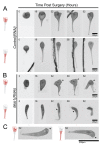The kinase regulator mob1 acts as a patterning protein for stentor morphogenesis
- PMID: 24823688
- PMCID: PMC4019465
- DOI: 10.1371/journal.pbio.1001861
The kinase regulator mob1 acts as a patterning protein for stentor morphogenesis
Abstract
Morphogenesis and pattern formation are vital processes in any organism, whether unicellular or multicellular. But in contrast to the developmental biology of plants and animals, the principles of morphogenesis and pattern formation in single cells remain largely unknown. Although all cells develop patterns, they are most obvious in ciliates; hence, we have turned to a classical unicellular model system, the giant ciliate Stentor coeruleus. Here we show that the RNA interference (RNAi) machinery is conserved in Stentor. Using RNAi, we identify the kinase coactivator Mob1--with conserved functions in cell division and morphogenesis from plants to humans-as an asymmetrically localized patterning protein required for global patterning during development and regeneration in Stentor. Our studies reopen the door for Stentor as a model regeneration system.
Conflict of interest statement
The authors have declared that no competing interests exist.
Figures








Comment in
-
Heads, tails, and tools: morphogenesis of a giant single-celled organism.PLoS Biol. 2014 May 13;12(5):e1001862. doi: 10.1371/journal.pbio.1001862. eCollection 2014 May. PLoS Biol. 2014. PMID: 24823912 Free PMC article. No abstract available.
-
Morphogenesis: a Mob rules from the rear.Curr Biol. 2014 Aug 4;24(15):R700-2. doi: 10.1016/j.cub.2014.06.042. Curr Biol. 2014. PMID: 25093564
References
-
- Kirschner M, Gerhart J, Mitchison T (2000) Molecular “vitalism” review. Cell 100: 79–88. - PubMed
-
- Shulman J, St Johnston D (1999) Pattern formation in single cells. Trends Cell Biol 15: M60–M64. - PubMed
-
- Trembley A (1744) Translation of a letter from Mr. Abraham Trembley, F. R. S. to the President, with observations upon several newly discover'd species of fresh-water polypi. Philos Trans R Soc Lond B Biol Sci 43: 169–183 10.1098/rstl.1744.0040 - DOI
-
- Tartar V (1961) The biology of stentor. New York: Pergamon Press. 434 pp.
-
- Morgan T (1901) Regeneration of proportionate structures in Stentor. Biol Bull 2: 311.
Publication types
MeSH terms
Substances
Grants and funding
LinkOut - more resources
Full Text Sources
Other Literature Sources

